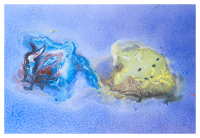Conveners
Parallel IV: D1 Deconfinement: Jets I
- Peter Arnold (University of Virginia)
Pasquale Di Nezza
(Istituto Nazionale Fisica Nucleare (IT))
08/09/2014, 14:00
Section D: Deconfinement
Hard partons produced in the initial stage of heavy-ion collisions are ideal probes to study the quark-gluon plasma (QGP). Those hard partons, that fragment into jets, experience a sizable energy degradation as they traverse the hot and dense medium generated in ultra-relativistic heavy-ion collisions. At the LHC regimes, the phenomena connected to the jet quenching unveils new interesting...
Barbara Betz
(Frankfurt University)
08/09/2014, 14:30
Section D: Deconfinement
Results based on a generic dE/dx-model that interpolates between running coupling pQCD based models such as CUJET2.0 and AdS/CFT-inspired holographic prescriptions are compared to recent data on the high-pT pion nuclear modification factors and the high-pT elliptic flow in nuclear
collisions at RHIC and LHC. The jet-energy loss models are coupled to state-of-the-art viscous hydrodynamic...
Edmond Iancu
(Institut de Physique Théorique de Saclay)
08/09/2014, 15:00
Section D: Deconfinement
We discuss average properties of the gluon cascade generated by an energetic parton propagating through a dense QCD medium. The cascade is mostly made with relatively soft gluons, whose production is not suppressed by the LPM effect. Unlike for usual QCD cascades in the vacuum, where the typical splittings are very asymmetric (soft and collinear), the medium-induced branchings are...
Bronislav Zakharov
(Landau Institute)
08/09/2014, 15:30
Section D: Deconfinement
We study jet quenching in $pp$ and $pA$ collisions in the scenario with
formation of a mini quark-gluon plasma.
We find a significant suppression effect. For light hadrons
at $p_{T}\sim 10$ GeV we obtained the reduction of the spectra
by $\sim [20-30,25-35,30-40]$% in $pp$ collisions at
$\sqrt{s}=[0.2, 2.76,7]$ TeV.
We also give predictions for modification of the photon-tagged
and...
